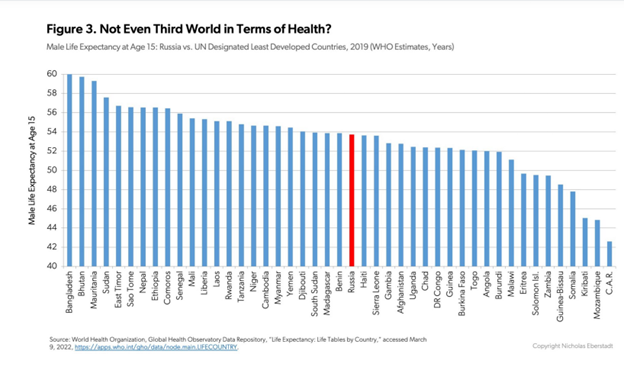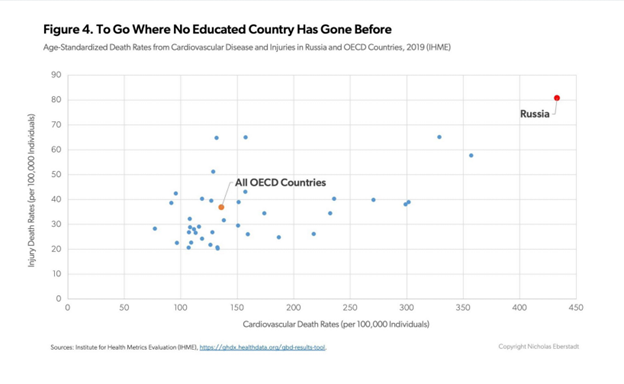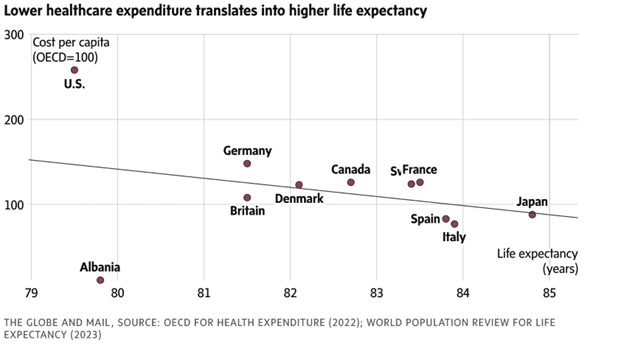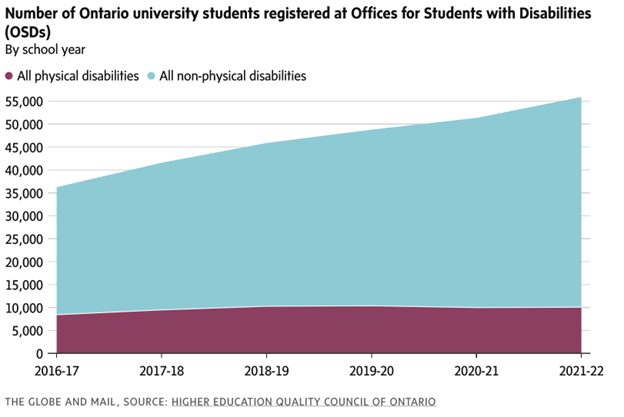My title is a bit inaccurate, maybe even a lot, because even though people write and talk a lot about the ‘Canadian’ health care system, in fact health care is a provincial responsibility. The Canada Health Act is intended to promote some level of commonality across the provincial systems, but I have little doubt that there is a good deal of variation in the quality and timeliness of the provision of health care services across the provinces.
Still, folks do talk as though we have a ‘Canadian system’, and the report by my favourite Canadian think tank, the Fraser Institute, that prompted this article is no exception.
Before I tell you about that, here’s a different report regarding what Canadians think about the health care system. In a poll done in August of ’23, Angus Reid asked a sample of Canadians a variety of questions about health care. Some highlights (you can read the entire AR report here):
– two-thirds of Canadians (66%) think there are structural problems within health care that will not be solved with more funding.
– 19% reported not having a family doctor, and 29% reported that they have one but find it difficult to get in to see them.
– 68% did not expect to see improvement in health care system in two years, and 56% did not expect to see improvement in five years.
– 68% report they think their province is doing a poor or terrible job measuring health care system performance, and 69% think that performance would improve if key health care indicators were made public.
Now this is an interesting snapshot of what a sample of Canadians think about the health care system under which they live, but it prompts a lot of questions. What health care indicators do the people surveyed have in mind? What do they mean when they tick the box ‘there are structural problems in health care that money won’t fix’?
Still, the survey suggests a lot of folks aren’t happy with the system, and my own circle of friends and acquaintances echoes that, although I will add that, in my experience, there is also a not-insignificant set of people who get angry at the suggestion that Canada has anything less than one of the best health care systems in the world.
Which leads one to wonder – at least it leads me to wonder – just how good is it?
Well, the good ol’ Fraser Institute wondered that too, and the result of that wondering is a new report from them titled ‘Comparing Performance of Universal Health Care Countries, 2024’, which you can download and read here. Really, all 66 pages, no paywall.
Suspecting that not all my readers are as enthusiastic about 66 pages of numbers, graphs and tables as am I, I valiantly dug in to see what I could learn and then report on here.
One thing to note right off is that Fraser decided to look only at OECD countries with relatively high incomes, and only those with universal health care systems. That tossed the USA out of the comparison right off, as well as low income countries like Mexico, Costa Rica and Poland. This left 31 countries that met the Fraser criteria, and it includes all the countries you would expect: Canada, the UK, France, Germany, Australia and New Zealand, even Israel and Slovenia.
There’s a lot in the report obviously, and the first key comparison is – how much does Canada spend on its health care system relative to these other countries? The next comparison will be, of course – what we get for that spending.
The first question is answered in two ways. First converting all monetary amounts into US dollars (despite its absence from the list) at purchasing power parity exchange rates (don’t ask) it does two international comparisons. One looking at expenditures as a percentage of GDP, and a second looking at expenditures per capita.
Canada is the fourth highest spending country on the first measure, spending 11.5% of its GDP on health care, trailing only Germany, Switzerland and New Zealand. On a per-capita basis, Canada comes in 9th of 31 countries, spending $US7035/person, the leader of the pack being Switzerland at $US9218/person.
So, Canada’s system is not inexpensive. We spend a bigger chunk of our national income on health care than all but three other rich countries and are in the top half of countries ranked by spending per person.
So now, what do we get for this?
This is much harder to measure in any credible way than are expenditures, so Fraser measures a lot of different things to try and get a handle on what and how well the system delivers. An imperfect place to start is to measure inputs. How well does the system do in providing the labour and capital (cuz that’s what it is, folks) that is needed to deliver health care services?
The answers are varied.
Canada ranks 28/31 in the number of physicians per capita, but a better 13/31 in the number of nurses per capita. However we slip to 25/31 in the number of each of overnight-stay and psychiatric hospital beds per capita. We are 27th in MRI units per capita and 28th in CT scanners. We are a surprising 3rd in Gamma scanners per capita, a device that detects gamma radiation emitted by radioisotopes. (I had to look that up.)
Canada doesn’t look good on this dimension outside that gamma scanner thing, but the report notes quite reasonably that what matters is not inputs but output. When these people and equipment go to work, what results do they get?
This is even harder to measure (it’s relatively easy to count people and pieces of equipment).
So….
Step 1: How well are the people and equipment utilized?
Two countries were left out of this part of the report for lack of data, but
Canada ranks 17/29 in doctor consultations per capita, 22/27 in MRI exams per capita, 13/27 in CT scans per capita.
We squeaked into the top half on that last one, but Canada also ranked dead-last in ‘curative-care discharge rates’ from hospitals, which are basically instances per thousand population of a patient being admitted to a hospital for treatment of an illness or injury (so, not maternity stays, for example) and then being discharged.
So, last in just going to the hospital to be treated and released. Hard to give that a positive spin, I think. (Thinking about it, that number could be low either because we have a hard time getting into the hospital to be treated, or because when we are, we tend to die rather than be discharged. Or both.)
And now, everybody’s favourite….ok, my favourite, waiting to be treated.
The set of countries in this ranking is even smaller, and I’m not sure why. The countries included are Netherlands, New Zealand, Canada, Switzerland, Germany, Australia, France, Sweden and Switzerland.
– 65% of Canadians reported waiting more than one month for an appointment with a specialist, placing Canada 8th out of 9. [France was even higher. Sacre bleu.]
– 58% waited more than two months for elective surgery, placing Canada 9/9.
Based on the stories I hear from my (admittedly mostly not-young) friends, I find it amazing that 42% of Canadians apparently got elective surgery of any kind in less than two months. I will add the cautionary note that this is based on patient self-reports, which are never the most accurate stats. Ideally one would like administrative data on wait times.
Anyway, on to –
Step 2: what happens to people who do get into the system?
There are a number of measures of how well the system actually does in making people better. I won’t go through them all, but here are a few so you can see what sorts of things are involved and how we did. Not all the 31 countries are included in each measure, data again.
a. The rate of diabetes-related lower extremity amputations was not statistically different from the 23-country average.
b. Canada ranked 8th (out of 26) for performance on the indicator measuring 30-day mortality after admission to hospital for acute myocardial infarction (heart attack) which was statistically better than the average.
c. 11th (out of 26) for performance on the indicator measuring 30-day mortality after admission to hospital for a hemorrhagic stroke, which is not statistically different from the average, and
d. 15th (out of 26) for performance on the indicator measuring 30-day mortality after admission to hospital for an ischemic stroke, which is also not statistically different from the average.
Wait, there’s more….
e. Canada ranks 5th (out of 28) on the indicator measuring the rate of 5-year survival after treatment for breast cancer (statistically better than average),
f. 11th (out of 28) for the rate of 5-year survival after treatment for cervical cancer (not statistically different from the average),
g. 8th (out of 28) for the rate of 5-year survival after treatment for colon cancer (statistically better than average),
h. 6th (out of 28) for the rate of 5-year survival after treatment for rectal cancer (statistically better than average)
Clearly, Canada does okay on these measures overall, so I will take a paragraph here to note what I think is ironic The most terrible thing you can suggest to most Canadians is that we make our health care system more like that of the US. In fact, no one reasonable ever suggests that, but Canadians seem to be terrified of the very idea of the US system, which they think leaves people dying on the sidewalk, unless they can afford the Cadillac-level health care available to those with money and/or good jobs.
But what this report suggests is that Canadians have a terrible time getting access to health care, yet if they do, the system does a good job of treating them. So, in the US access is difficult unless you have money, but you get good care if you get in, while in Canada access is difficult because governments won’t spend the necessary money, but again, if you get in, you get good care.
Not what I would have expected before reading this report.
There’s a lot more in it, including comparisons of longevity and mortality and such. I don’t think those things tell us anything much about our health care system, as they depend on too many other things, so I will pass on reporting them, but you can read the report if you’re interested. The one exception is ‘treatable mortality’, which, as its name suggests, is mortality from causes that a health care system can ameliorate. On that measure, Canada is 20/31, not terrible, consistent with the numbers we just saw.
My bottom line is what it has been for a long time regarding the Canadian Health Care System. Despite it’s acronym, OHIP is not an Insurance Program. It may have been at the start, based on what I have read about its origins. Now, it has morphed into an all-encompassing bureaucratic nightmare in which too many decisions are made at too high a level. The politicians and high-level bureaucrats in Ontario try to ‘run’ the system from Queens Park, and if the Soviet Union was not sufficient demonstration that that doesn’t work I don’t know what could be. In addition, politicians are unwilling to commit the spending to the system needed to reduce wait times and ameliorate other access issues, because doing so would make it much harder for them to do the things they believe will get them re-elected: subsidies to manufacturing plants, sending cheques to taxpayers and the like.
I have seen the enemy of good health care, and it ain’t us, it’s the people we vote into office. All of them.






